Agriculture Reference
In-Depth Information
retention reactions associated with type 1 sites were not only dominant but
also closer to local equilibrium than those for type 2 sites (results not shown).
This is a direct consequence of the limited solute residence time encountered
when the fluid flow velocity is exceedingly high. Type 2 sites, which may
be considered highly kinetic, were far removed from equilibrium such that
only a limited amount of solute was retained from the soil solution. Under
such conditions, the number of available sites (ϕ) remains high and the reten-
tion capacity of the soil matrix is therefore not achieved. In fact, for
q
= 40
cm/day, the BTC describes closely a one site retention mechanism as indi-
cated by the low retardation and lack of tailing of the desorption side. As the
flow velocity decreases the solute residence time increases and more time is
available for the highly kinetic type 2 sites to retain solute species from the
soil solution. In addition, for extremely small velocities the BTC should indi-
cate maximum solute retention during transport. This probably resembles
the BTCs with
q
= 0.1 cm/day, which indicates the highest solute retardation
shown. For intermediate velocities (
q
from 1 to 10), however, the respective
BTCs indicate relatively moderate degrees of retardation as well as tailing,
which is indicative of kinetic retention mechanisms.
In the BTCs shown in Figures 6.4, 6.5, and 6.6 the irreversible retention mecha-
nism for reactive chemical removal (via the sink term) was ignored. The influence
of the irreversible kinetic reaction (e.g., precipitation) is a straightforward one as
shown in Figure 6.7. This is manifested by the lowering of solute concentration
for the overall BTC for increasing values of
k
s
. Since a first-order reaction was
assumed the lowering of the BTC is proportional to the solution concentration.
In previous BTCs, the sensitivity of model predictions (output) of the
second-order approach to selected parameters was discussed. It is conve-
nient, however, to assess model sensitivity using dimensionless parameters
1.0
k
s
= 0 hr
-1
0.8
0.05
0.10
0.6
0.4
0.2
0
0
1
2
3
4
5
6
7
8
9 0
V/V
o
FIGURE 6.7
Effluent concentration distributions for values of the irreversible rate coefficient (
k
s
) using the
second-order model. (From H. M. Selim and M. C. Amacher. 1997.
Reactivity and Transport of
Heavy Metals in Soils
. Boca Raton, FL: CRC Press. With permission.)



Search WWH ::

Custom Search